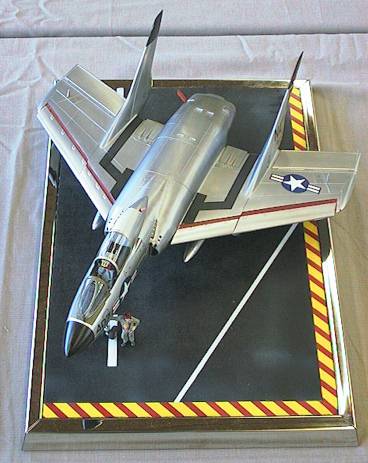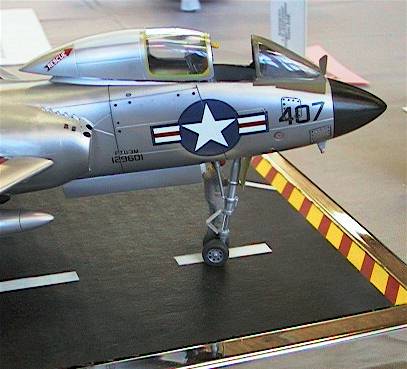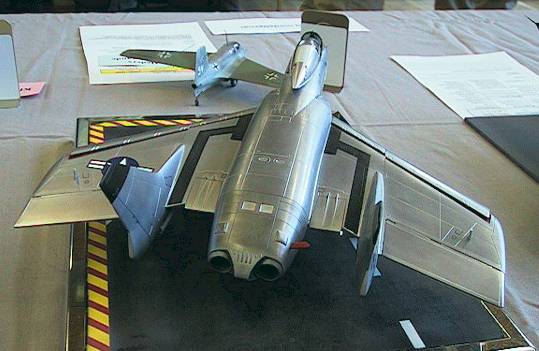Hobbycraft F7U-3 built with a reason
By Martin Waligorski
based on the model description by L-G Johansson
”I remember seeing this aircraft for the first time back in 1950s. I was a 10-years old lad wearing those rubber football shoes. I saw pictures of the Cutlass in a magazine, blazing across the sky with its pointed nose, swept wing and double fins, and I thought it was extremely cool. This aircraft had something special about it, and today, 50 years of aviation development later, I still think it does! There is something very special about the Cutlass!”
These are the words of L-G Johansson, the builder of this 1/48 Hobbycraft Vought F7U-3 Cutlass.
Despite L-G’s fond memories, few fighter aircraft in the Navy history were so unsuccessful as the F7U.
The Cutlass was born in the latter part of 1945 out of the aerodynamical research on tailless designs brought over to the U.S from Germany. Elaboration of these designs by the Chance Vought company led to a highly unconventional aircraft. The wing, with a sweepback of 38 degrees, was of very low aspect ratio 3 :1, and almost parallel chord. Pitch and roll controls were combined in elevons on the wing; fins and rudders were located on the wing at the ends of the centre section.
So long it all looked well, and the press loved the  modern look of the plane. At the aircraft’s unveiling, journalists were so stunned by its unusual appearance that the plane was given such nicknames as bat-like, dart-like, praying mantis, preying petrodactyl, giant arrowhead and flying wing. Through the press the enthusiasm eventually reached young L-G in Sweden.
modern look of the plane. At the aircraft’s unveiling, journalists were so stunned by its unusual appearance that the plane was given such nicknames as bat-like, dart-like, praying mantis, preying petrodactyl, giant arrowhead and flying wing. Through the press the enthusiasm eventually reached young L-G in Sweden.
As it turned out, the reality was far from the image. The chronic lack of power of the two J46 jest engines forced the designers to install two afterburners to facilitate take-off (!). Afterburners were also required for deck landings. Topping off the problem, the engines could not be pushed above 85% of full power because of the uncontrolled vibrations. Nose landing gear had a constant tendency to collapse, and fuselage-mounted guns caused the engines to choke and flame-off when fired. Last but not least, the aircraft showed some nasty instability in the air.
Navy test pilot John Moore said: ”The Cutlass could be made into a pretty good flying machine with a few modifications, like adding a conventional tail, at least three times the thrust, cutting the nose-wheel in half, completely redoing the flight control system and getting someone else to fly it.”
It never made it into active service. The F7U-1 was relegated to trainer duties, and the improved F7U-3 (which had so many changes that it could almost be regarded as a new aircraft) flew as a missile platform or photo-reconnaissance machine. In late-1950s, the Cutlass was quickly forgotten, and the remaining aircraft were either scrapped or given away to museums – some with as little as 50 hours flying time.
 The model
The model
Unfortunate machines like this one make particularly attractive modelling subjects.
There is only one option to build the Cutlass in 1/48 scale – Hobbycraft. For the record, there was another kit made by Lindberg back when the aircraft was press news, showing one of the prototypes in the attractive Blue Angels livery. Hobbycraft have released their kit around 1990.
Through kits like the Cutlass, Hobbycraft of Canada lives up to its name – these kits can only be made to good models by a great deal of craft. Some people say that this kit has been scaled up from Fujimi 1/72 Cutlass with no extra detail added… The general shapes are correct, but the detail ranges from raw on the surface to non-existent in cockpit and wheel wells. Consistently with cockpit detail, kit transparencies are thick and effectively distorting the view of anything you would like to see through them. On the plus side, flaps and slats are separate pieces so that they can be positioned off-centre if you like.
L-G’s modifications included a detailed cockpit with canopy in open position and a few other extra details. Preparation for the natural metal finish required a lot of filling, sanding and polishing, especially at the joint lines, which most often were on the loose side. And there it is, a fine representation of the Cutlass: the circle is completed for L-Gs childhood memories. Hobbycraft should still be commended for providing a kit of one of the more unusual aircraft out there!
This article was originally published in IPMS Stockholm Magazine in August 2002.


